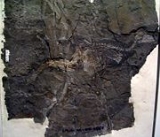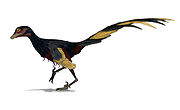
Jinfengopteryx
Encyclopedia
Jinfengopteryx is a genus
of maniraptora
n dinosaur
. It was found in the Qiaotou member of the Huajiying Formation
of Hebei
Province, China
, and is therefore of uncertain age. The Qiaotou Member may correlate with the more well-known Early Cretaceous
Yixian Formation
, and so probably dates to around 122 Ma ago.
or Anchiornis
. It also preserves several small, oval structures that are reddish yellow in color, probably seeds that the dinosaur had eaten before it died.
 The authors of the original description considered Jinfengopteryx to be the most basal avialan
The authors of the original description considered Jinfengopteryx to be the most basal avialan
(bird), and a member of the family Archaeopterygidae
. In a 2007 follow-up paper, they went on to compare Jinfengopteryx and Archaeopteryx
, still supporting its placement as an archaeopterygid, but providing no phylogenetic analysis. However, Luis Chiappe pointed out that Jingengopteryx appears to have more in common with the troodontids
, such as an enlarged claw on its short second toe, and that numerous scientists suspect it may belong to that group. In 2006, Xu and Norell also suggested that Jinfengopteryx was a troodontid, based on general body plan and features of the teeth. In a 2007 analysis of the relationships between troodontids, dromaeosaurids, and early birds, Turner and colleagues did find Jinfengopteryx to be a troodontid, and referred it to that group, noting that it is the first troodontid specimen to preserve evidence of feathers.
Genus
In biology, a genus is a low-level taxonomic rank used in the biological classification of living and fossil organisms, which is an example of definition by genus and differentia...
of maniraptora
Maniraptora
Maniraptora is a clade of coelurosaurian dinosaurs which includes the birds and the dinosaurs that were more closely related to them than to Ornithomimus velox. It contains the major subgroups Avialae, Deinonychosauria, Oviraptorosauria and Therizinosauria. Ornitholestes and the Alvarezsauroidea...
n dinosaur
Dinosaur
Dinosaurs are a diverse group of animals of the clade and superorder Dinosauria. They were the dominant terrestrial vertebrates for over 160 million years, from the late Triassic period until the end of the Cretaceous , when the Cretaceous–Paleogene extinction event led to the extinction of...
. It was found in the Qiaotou member of the Huajiying Formation
Huajiying Formation
The Huajiying Formation is a geological formation in Hebei, People's Republic of China. Known for its fossils including primitive birds, the age of the ormation is uncertain. It may represent an early portion of the Jehol Biota, dating to somewhere in the early Cretaceous or late Jurassic periods...
of Hebei
Hebei
' is a province of the People's Republic of China in the North China region. Its one-character abbreviation is "" , named after Ji Province, a Han Dynasty province that included what is now southern Hebei...
Province, China
China
Chinese civilization may refer to:* China for more general discussion of the country.* Chinese culture* Greater China, the transnational community of ethnic Chinese.* History of China* Sinosphere, the area historically affected by Chinese culture...
, and is therefore of uncertain age. The Qiaotou Member may correlate with the more well-known Early Cretaceous
Early Cretaceous
The Early Cretaceous or the Lower Cretaceous , is the earlier or lower of the two major divisions of the Cretaceous...
Yixian Formation
Yixian Formation
The Yixian Formation is a geological formation in Jinzhou, Liaoning, People's Republic of China, that spans 11 million years during the early Cretaceous period...
, and so probably dates to around 122 Ma ago.
Description
Jinfengopteryx is known from one specimen (number CAGS-IG-04-0801), a nearly complete articulated skeleton, which measured 55 cm (2 ft) long. It was preserved with extensive impressions of pennaceous feathers, but it lacks flight feathers on its hind legs, which are present in related dinosaurs such as PedopennaPedopenna
Pedopenna is a genus of small, feathered, maniraptoran dinosaur from the Daohugou Beds in China. It is possibly older than Archaeopteryx, though the age of the Daohugou Beds where it was found is debated...
or Anchiornis
Anchiornis
Anchiornis is a genus of small, feathered, deinonychosaurian dinosaur. The genus Anchiornis contains the type species Anchiornis huxleyi, named in honor of Thomas Henry Huxley, an early proponent of biological evolution, and the first to propose a close evolutionary relationship between birds and...
. It also preserves several small, oval structures that are reddish yellow in color, probably seeds that the dinosaur had eaten before it died.
Classification

Avialae
Avialae is a clade of dinosaurs containing their only living representatives, birds , and the most immediate extinct relatives of birds.-Competing definitions:...
(bird), and a member of the family Archaeopterygidae
Archaeopterygidae
The Archaeopterygidae is a group of maniraptoran dinosaurs that lived during the late Jurassic and period.-Taxonomy:The order Archaeopterygiformes was coined by Max Fürbringer in 1888 to contain the single family Archaeopterygidae and genus Archaeopteryx...
. In a 2007 follow-up paper, they went on to compare Jinfengopteryx and Archaeopteryx
Archaeopteryx
Archaeopteryx , sometimes referred to by its German name Urvogel , is a genus of theropod dinosaur that is closely related to birds. The name derives from the Ancient Greek meaning "ancient", and , meaning "feather" or "wing"...
, still supporting its placement as an archaeopterygid, but providing no phylogenetic analysis. However, Luis Chiappe pointed out that Jingengopteryx appears to have more in common with the troodontids
Troodontidae
Troodontidae is a family of bird-like theropod dinosaurs. During most of the 20th century, troodontid fossils were few and scrappy and they have therefore been allied, at various times, with many dinosaurian lineages...
, such as an enlarged claw on its short second toe, and that numerous scientists suspect it may belong to that group. In 2006, Xu and Norell also suggested that Jinfengopteryx was a troodontid, based on general body plan and features of the teeth. In a 2007 analysis of the relationships between troodontids, dromaeosaurids, and early birds, Turner and colleagues did find Jinfengopteryx to be a troodontid, and referred it to that group, noting that it is the first troodontid specimen to preserve evidence of feathers.

